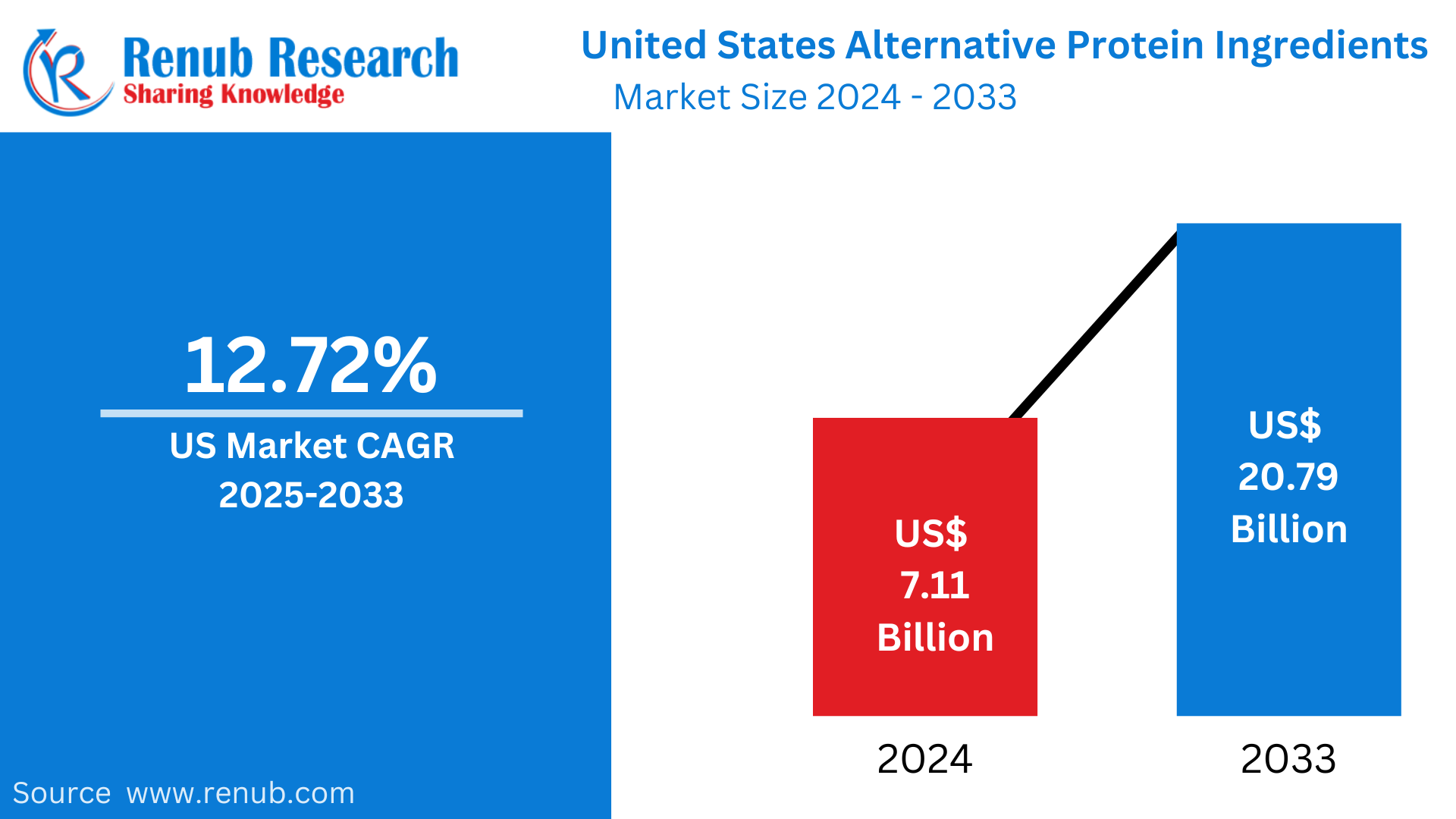United States Alternative Protein Ingredients Market
Size and Share Analysis – Growth Trends and Forecast Report 2025-2033
Market Overview
The United States Alternative Protein Ingredients Market is poised for remarkable expansion—from USD 7.11 billion in 2024 to an estimated USD 20.79 billion by 2033. This robust growth, registering a CAGR of 12.72% from 2025 to 2033, is driven primarily by the increasing consumer demand for sustainable, plant-based protein alternatives and the substantial advances in food technology. As health awareness rises and new alternative protein products are developed, innovative solutions are transforming the food and beverage landscape in the U.S.
What are Alternative Protein Ingredients?
Alternative protein ingredients are unconventional protein sources sourced from:
- Plants (e.g., wheat, rice, oats, soy, pea, lupine, chickpea, potato, almond, and others),
- Insects (e.g., Coleoptera, Lepidoptera, Hymenoptera, Orthoptera, Hemiptera, Diptera, and others),
- Microbes (from algae, bacteria, yeast, fungi, precision fermentation processes),
- And even animal-derived proteins such as dairy (casein or whey) and egg proteins in certain formulations.
These ingredients serve as environmentally friendly alternatives to animal proteins—widely used in meat and dairy substitutes, protein supplements, and various food formulations. Their appeal lies in delivering essential nutrients while reducing the environmental footprint inherent in traditional meat production.
Key Growth Drivers
1. Rising Consumer Demand for Plant-Based Diets
- Trend: There is a marked increase in the number of U.S. consumers adopting vegetarian, vegan, and flexitarian lifestyles.
- Impact: This shift is driven by health concerns, environmental sustainability, and ethical considerations related to animal welfare.
- Example: Major food chains and retailers have aggressively expanded their plant-based offerings, helping to normalize the consumption of meat and dairy alternatives.
- Industry Move: In September 2022, the Plant Based Foods Association (PBFA) launched the Plant Based Foods Institute (PBFI) to improve the food system through plant-based innovation.
2. Advancements in Food Technology and Innovation
- Technologies in Focus: Precision fermentation, cellular agriculture, and advanced extrusion methods have dramatically improved the taste, texture, and nutritional quality of alternative protein ingredients.
- Benefits: New technologies are enabling the development of plant and lab-grown proteins that closely mimic conventional meat and dairy products.
- Industry Example: In February 2024, Califia Farms introduced “Califia Farms Complete,” a plant-based milk protein derived from chickpea, pea, and fava bean proteins that offers improved nutritional profiles and lower sugar content.
3. Environmental and Sustainability Concerns
- Consumer Mindset: Increasing concerns over climate change, deforestation, and high water usage in traditional animal farming are pushing consumers toward alternatives with a lower carbon footprint.
- Policy Influence: Government policies and corporate sustainability initiatives, such as the PLANT Act introduced in July 2023, are designed to secure USDA support for plant-based diets which could lead to substantial savings in healthcare costs while reducing environmental impact.
- Result: A growing trend toward eco-friendly and sustainable food choices is driving increased investment in alternative protein ingredients.
Market Challenges
High Production Costs and Price Sensitivity
- Issue: Despite the surge in demand, many alternative protein products remain more expensive than their animal-derived counterparts due to high research and production costs.
- Consequence: Consumers in price-sensitive segments may continue to favor traditional protein sources, limiting market penetration.
- Need: Manufacturers must focus on reducing production costs and scaling operations to make these alternatives more competitive.
Consumer Acceptance and Sensory Perception
- Challenge: Taste, texture, and cultural acceptance are critical hurdles.
- Explanation: Many alternative proteins—especially those derived from insects or microbial sources—face skepticism regarding flavor and overall quality.
- Solution: Enhanced product development, targeted marketing campaigns, and consumer education initiatives are essential to overcome these barriers.
Detailed Segment Analysis
A. Source Type
1. Plant-Based Proteins
- Key Ingredients: Wheat (gluten, seitan), Rice, Oats, Soy, Pea, Lupine, Chickpea, Potato, Almond, and others.
- Trend: Soy remains dominant due to its nutritional profile and cost-effectiveness, although concerns over allergies and deforestation are spurring interest in other plant alternatives.
2. Insect-Based Proteins
- Key Categories: Protein sources from Coleoptera (beetles), Lepidoptera, Hymenoptera, Orthoptera, Hemiptera, Diptera, and others.
- Application: Largely utilized in animal feed formulations with gradual exploration in human food segments hindered by regulatory and cultural issues.
3. Microbial-Based Proteins
- Key Ingredients: Proteins from algae (e.g., spirulina, chlorella), bacteria, yeast, fungi, and products derived from precision fermentation.
- Significance: These sources are gaining traction in dietary supplements, functional foods, and innovative meat analogs. Yeast proteins, in particular, add a unique umami flavor and are rich in B vitamins.
B. Application Sectors
1. Food & Beverage
- Products: Plant-based burgers, dairy alternatives, protein bars, and ready-to-drink beverages.
2. Animal Feed
- Trend: Alternative proteins are increasingly incorporated as sustainable replacements for conventional feed ingredients like soybean and fishmeal.
3. Dietary Supplements
- Development: Protein powders and fortified food items address the nutritional needs of health-conscious consumers.
4. Others
- Niche Applications: Include uses in pharmaceuticals, cosmetics, and specialty nutrition products.
C. Regional Insights
East U.S.
- Overview: Major urban centers such as New York, Boston, and Washington, D.C., show high demand driven by health-conscious urban consumers and a well-established retail infrastructure.
West U.S.
- Overview: California, especially Silicon Valley, leads innovation with a high concentration of food-tech startups and venture capital in alternative proteins.
North & South U.S.
- Trend: Regions outside the coasts are witnessing growing adoption, particularly in dietary supplements and animal feed sectors, supported by increasing awareness and distribution networks.
Related Report
- North America Animal Protein Market Size and Share Analysis – Growth Trends and Forecast Report 2025-2033
- North America Protein Market Size and Share Analysis – Growth Trends and Forecast Report 2025-2033
- North America Protein Bar Market Size and Share Analysis – Growth Trends and Forecast Report 2025-2033
Competitive Landscape
Key Players in the U.S. Alternative Protein Ingredients Market:
- Beyond Meat
- Impossible Foods Inc.
- Archer Daniels Midland (ADM)
- Cargill Inc.
- Roquette Frères
- Tyson Foods Inc.
- Ingredion Incorporated
- Novozymes
- Kerry Group
- DuPont Nutrition & Biosciences
These companies are analyzed based on:
- Company Overview
- Key Executives and Strategic Decisions
- Revenue Performance
- Recent Developments and Product Innovations
Future Outlook and Opportunities
The future of the U.S. alternative protein market hinges on:
- Technology Integration: Further improvements in precision fermentation, cellular agriculture, and other food technology innovations.
- Scaling Production: Strategies to reduce production costs and lower retail prices.
- Market Penetration: Expanding consumer acceptance through improved sensory profiles and rigorous education campaigns.
- Regulatory Support: Government policies like the PLANT Act are crucial to driving further adoption of sustainable, alternative protein sources.
Key Questions Answered in This Report
- What is the projected market size of the United States Alternative Protein Ingredients Market by 2033?
- What is the expected CAGR from 2025 to 2033 in this market?
- How are the growing consumer demand for plant-based diets and sustainable protein sources impacting market growth?
- What technological advancements are driving improvements in food processing and alternative protein quality?
- How do environmental and sustainability concerns influence consumer choices and industry strategies?
- What are the primary cost challenges in scaling production for alternative proteins?
- How is consumer acceptance being shaped by taste, texture, and cultural factors?
- Which are the dominant alternative protein sources (plant-based, insect-based, microbial-based) and their respective applications?
- What regional trends are notable in the U.S.—particularly between the East and West regions?
- Who are the key players, and what competitive strategies are they employing to capture market share?
Report Specifications
- Base Year: 2024
- Historical Period: 2020 – 2024
- Forecast Period: 2025 – 2033
- Market Units: US$ Billion
- Segments Covered: Source Type, Application, and Region
- Regions Covered: East, West, North, South U.S.
- Delivery Format: PDF and Excel (Editable PPT/Word available on request)
- Customization Scope: 20% Free Customization
- Post-Sale Analyst Support: 1 Year (52 Weeks)
Available Customization Services
- Analysis of Market Size and Segments
- Additional Company Profiles (up to 10 without extra cost)
- Region/Country-Specific Reports
- Market Entry Strategy and Regional Dynamics
- Regional Market Share, Trade Analysis, and Production Insights
- Others as per customized requests
Contact and Licensing Information
For additional details, requests for customization, or to get a competitive edge with our report findings, please get in touch with our analysts.
- USA Phone: +1-478-202-3244
- India Phone: +91-120-421-9822
- Email: info@renub.com
Licensing Options
- Dashboard (Excel): $2,490
- Single User License (PDF): $2,990
- Five User License (PDF) + Excel: $3,490
- Corporate License: Multi User: $3,990
About Renub Research
Renub Research is a global market research and consulting firm with over 15 years of expertise in providing in-depth business-to-business insights, surveys, and consulting services across multiple industries.





